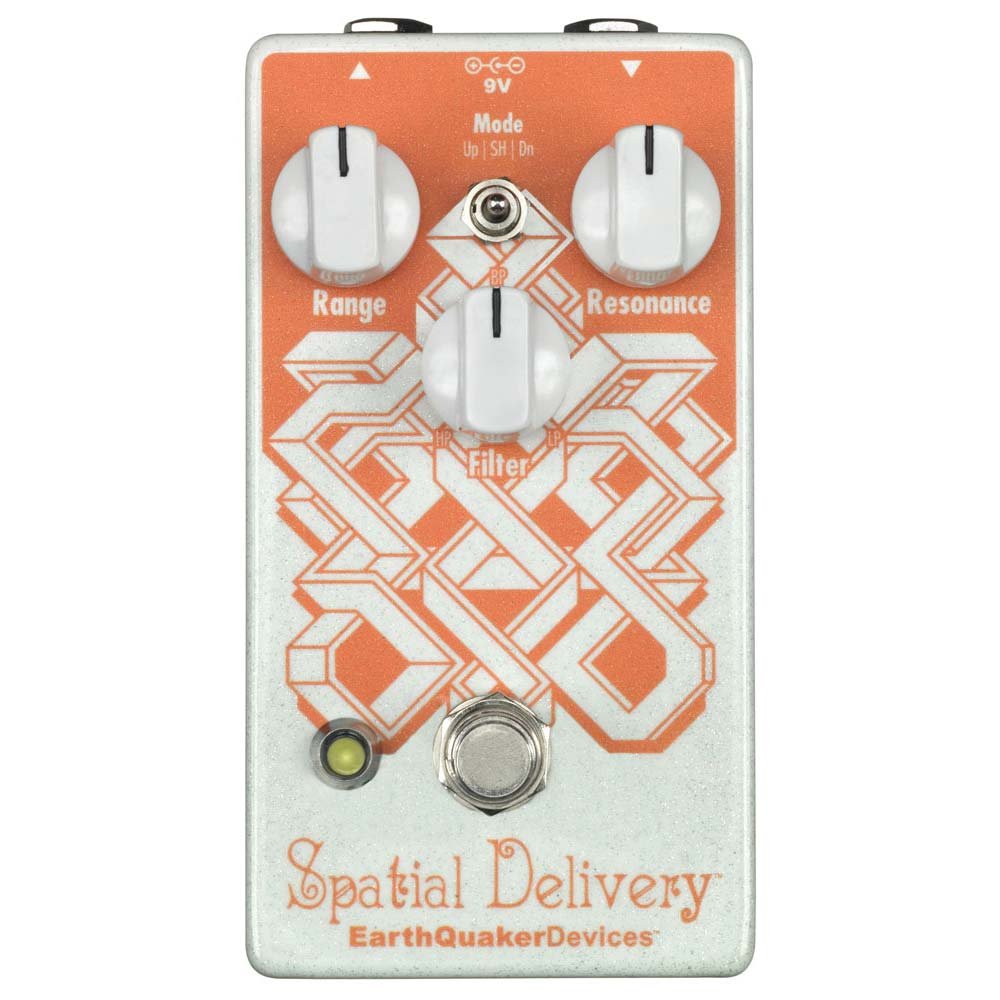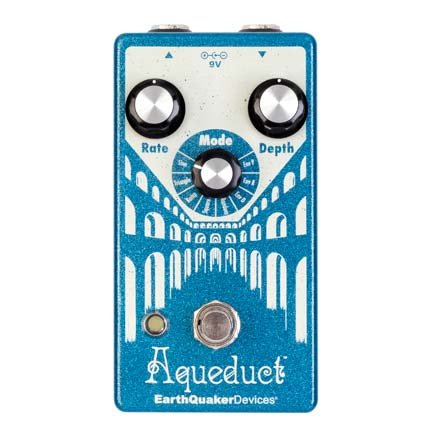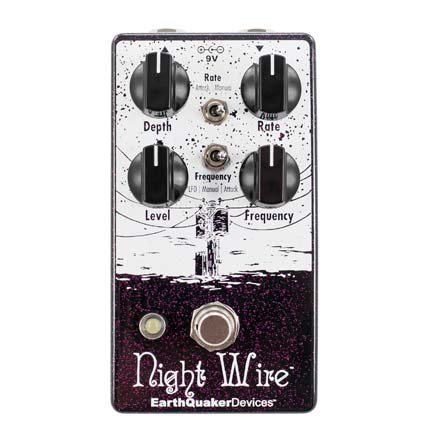Feel The Vibe (and Tremolo)
Malcolm X Abram
Welcome back, pedal heads! It's time for another walkthrough focusing on a specific category of EarthQuaker Devices for you to chew on as you fill out your dream pedalboard with cool-sounding stompboxes. Currently, EQD has two vibrato styles, the Aqueduct and The Depths, and two kinds of tremolo, Hummingbird and Night Wire, plus the Spatial Delivery envelope filter.
So here are a few basics that are good to know.
Tremolos and vibratos can sound similar, but they have one significant difference in how they affect the signal. Vibrato is a steady increase and decrease in pitch. Tremolo is a steady increase and decrease in volume.
METHOD OF OUR MADNESS
Since this category is more varied than fuzz, we can't quite make a strict side-by-side comparison because it's an apples-to-ribeye-steaks situation. Nevertheless, we would like to give you a sense of what each does to the same audio sample so you can choose which effect suits your musical needs. We've got our usual arpeggiated riffs and some chunky, lightly overdriven sounds, so you can clearly hear the filters and vibratos doing their respective things. For this one, the Upstairs Bedroom SoundLabs staff is using a Jazzmaster style HSS guitar (specifically, the pretty tame bridge humbucker) through a Mooer Taxidea Taxus digital preamp. The signal then goes into the Twin Reverb 2X12 preset on the Mooer Radar Speaker Cab Simulator and into a Focusrite Scarlett 4i4 and Presonus Studio One 5 with just a hint of the Waves TrueVerb plugin.
MEET THE PEDALS
Aqueduct
This pedal is inspired by vintage pitch vibratos. Though it has only two knobs, the standard Rate and Depth, the eight modulation modes available with the rotary switch make it a vibe jack-in-the-stompbox. You've got four different waveforms available: Sine, Triangle, Ramp, and Square, which turn the signal into various kinds of pulses, from a smooth light pitch tremors to big ol' squiggly, sharp rises and falls. The other four settings are very different Envelope controls affecting a sine wave-shaped version of your signal. In these modes, your pick attack determines the intensity of each effect.
The Depths
Another vibe, but this one is optical, meaning the LFO (low-frequency oscillator) uses an optocoupler, a tiny device that contains a light-emitting and light-sensitive component that allows an electrical signal to be transmitted between two isolated circuits. That's a fancy way of saying a tiny light is attached to a photocell, and the light triggers the cell, which triggers the vibrato. The Depths gives you considerable control over the vibrato, with knobs for Throb, which controls the low-end voice, the Intensity of the vibe, the Rate, and the Voice, which is a kind of EQ.
Stillman further clarifies the difference: "In the case of the Aqueduct and The Depths; The Depths is phase shift modulation like the Univibe, and the Aqueduct is pitch modulation like the Boss VB-2. They produce wildly different results. We use the word vibe more as a nod to Univibe than short for vibrato in this case. The Aqueduct is Pitch of Frequency modulation, and The Depths is Phase Modulation."
Hummingbird
A percussive tremolo (remember that's a steady decrease and increase in volume) that can give you that old school, gentle tremolo pulse or take your signal and chop it up into hard and fast, or slow bursts. It can almost reach ring mod territory if you crank the Rate knob way up. It also has expression control to do all kinds of cool rhythmic tricks with it. This little birdy isn't very complicated, but it can get weird for you if you want.
Night Wire
The other EQD tremolo is a bit more versatile. It's harmonic, so it splits the signal and puts it through two EQ filters and then through an LFO. That makes for a versatile tremolo that you can use in several ways. The Frequency toggle is its not-so-secret weapon. In Attack mode, your tremolo speed reacts to the heft of your pick attack, and you can use the Rate control to solely determine the tremolo speed. You can also use the LFO as a constant sweep in conjunction with the Frequency knob (LFO Mode) or use Manual mode and simply dial in the exact sound you want. It can function as a traditional tremolo, and you can also use it as an ersatz auto-wah using the Frequency, Rate, and Depth knobs in manual mode.
A few more words from Stillman: "As for tremolo, the Hummingbird is a pretty unique ramp wave tremolo. It's not your typical amp-style sine wave that's really smooth and natural. It has a pretty distinctive "ping" to it. The Night Wire is a harmonic tremolo that is kind of a mix between a phaser, filter, and a tremolo. Again, it's a very distinctive sound that can't be achieved by simply combining those types of stand-alone effects together. The Hummingbird would fall under Amplitude Modulation, and the Night Wire would fall under Phase Modulation and Amplitude Modulation.
Spatial Delivery
As stated on its product page, this pedal is indeed an "oddball." It's an envelope filter and can give you the essential autowah functions we all know and love and is an express route to funky town. The Spatial Delivery has Up and Down modes and a Range knob that is sensitive to pick attack, offering a crazy wide range of possible tones and accents. The pedal also has Sample and Hold function controlled by random voltage giving you that digital stutter effect and the Range knob controls the speed of the stutter. The Spatial Delivery is not really a set it and forget kind of pedal, it definitely requires some fiddling around with the controls to discover the many weird sounds it can produce.
TREMOLO AND VIBRATO
Night Wire
OK, let's move on into the wiggly, wobbly realm of tremolos and vibratos. We'll begin with one of the folks at UBSL's favorites, the Night Wire. It's pretty versatile because it works as a combo platter of phaser, tremolo, and filter. Like its modulating cousin, the Spatial Delivery, It can get auto-wah effects, traditional tremolo, and various phase and envelope effects. We're going to give you a taste of the toggle switch settings. We have the Rate switch set to attack, which turns the Rate knob into a Sensitivity knob. So throughout the clip, you'll hear how the arpeggios are mellow, and the full chords push the rate of the tremolo. Likewise, with the Frequency toggle in attack mode, the Frequency knob affects the sensitivity of the envelope. Between the two, players with good touch and a dynamic sense of their instrument can get some excellent variations with their chords and solos. For this clip, we have the Rate knob at 3 o'clock to help you hear the attack effect and the Frequency at about noon, so the filter doesn't get in the way.
For the second clip, we're in full funky autowah mode. Again, the Frequency toggle is in attack mode; the Depth knob is fully counterclockwise to remove the tremolo. We adjust the Frequency knob to affect the sensitivity and the center frequency to taste. We have it at about 9 p.m. for a good "wah" sound but to avoid getting too high a peak. Great for funky, syncopated riffs and adds some different flavor to solos without you needing to be attached to your wah-pedal.
Aqueduct
This little blue beauty only has two controls Rate and Depth. But its versatility is in the Mode knob. We have a simple 8-bar loop, and we're going to take through all of the modes in the following two clips. The Rate and Depth knobs are both set at noon for all modes. Consequently, some of the modes will sound weirder and less musical to some folks than if you dialed in your own settings for a specific tone. But we want to ensure you can clearly hear what each mode does to the signal. Clip #1 features, in sequence; Sine, Triangle, Ramp, and Square. Clip #2 has Random, Envelope-Controlled Depth, Envelope-Controlled Rate, and Envelope-Controlled Pitch. The Envelope controlled modes are sensitive to pick attack, giving you even more control. Check out the product for more details on all the modes.
The mode is switched at the end of each loop. Don't worry; you'll be able to notice the mode changes.
Hummingbird
The Hummingbird is a pretty straightforward percussive tremolo, which also works as a great clean boost when the tremolo is dialed back. There is nothing to fancy or any secret tricks to show off here. So we're cutting to the chase and playing with the expression pedal.
The Depths
For this clip, we'll be slowly turning the Voice knob from zero to fully clockwise, so you'll hear how the signal goes from a tighter midrangy tone to a looser one with more lows and bottom end. We've dimed the Rate knob while the Intensity knob is at 9 o'clock, and the Throb knob, which adds even more low end, is set at noon.
Spatial Delivery
As stated on its product page, this pedal is indeed an "oddball." It's an envelope filter and can give you the essential autowah functions we know and love to use to get funky, but it has a different quality than the Night Wire. We'll also give you a taste of the Sample and Hold function.
There you have it. EQD's line of vibratos, tremolos and envelope filters have everything you need for traditional uses. And, if you want to take it out to the sonic stratosphere, we got you! Enjoy!
Malcolm X Abram is a recovering reporter and music writer and a proud 40 year guitar noodler. He lives, works and plays in the bucolic dreamland of Akron, Ohio in an old house with two dogs who don’t really like each other and way too many spiders.














